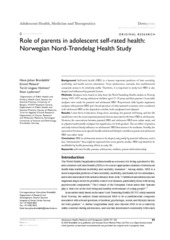Role of parents in adolescent self-rated health: Norwegian Nord-Trøndelag Health Study
Peer reviewed, Journal article
Published version
Permanent lenke
https://hdl.handle.net/1956/5713Utgivelsesdato
2010-09Metadata
Vis full innførselSamlinger
Originalversjon
Adolescent Health, Medicine and Therapeutics 2010(1): 97-104 https://doi.org/10.2147/ahmt.s12877Sammendrag
Background: Self-rated health (SRH) is a known important predictor of later mortality, morbidity, and health service attendance. From adolescence onwards, this multifactorial composite seems to be relatively stable. Therefore, it is important to study how SRH is also shaped and influenced by parental factors. Methods: Analyses were based on data from the Nord-Trøndelag Health studies in Norway during 1995–1997 among adolescent children aged 13–19 years and their parents. Cross-table analyses were made for parental and adolescent SRH. Proportional odds logistic regression analyses with parental SRH and a broad spectrum of other parental covariates were conducted, with adolescent SRH as the dependent variable, both unadjusted and adjusted. Results: Lower level of education, living alone, smoking, low general well being, and low life satisfaction were the most important parental factors associated with lower SRH in adolescents. However, the associations between parental SRH and adolescent SRH were rather weak, and in adjusted multivariable analyses lost significance for both genders. The net effect of genetics and early vertical family influence on adolescents’ SRH thus seems to be moderate. Notably, the association between more specific health-related and lifestyle variables in parent and adolescent SRH was rather weak. Conclusion: SRH in adolescents seems to be shaped only partly by parental influence, and is less “deterministic” than might be expected from some genetic studies. SRH may therefore be modifiable by health-promoting efforts in early life.

